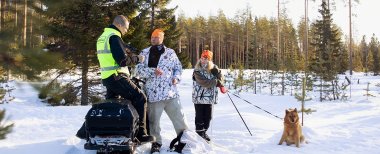Meeting a large carnivore
If you come across a large carnivore in the wild, keep calm. You should not shout or turn your back on the animal.
Large carnivores have always interested humans. Their large size and noticeable presence have both caused concern and sparked our interest. They are social and warm-blooded mammals, just like us, if only a bit hairier. They compete for the same food sources as us and they can be a potential threat to humans. For these reasons we both love and hate large carnivores and like to assign mythical qualities to them. We tell fables about them, use them in our metaphors and name things, objects and even sports teams after them.
If you come across a large carnivore in the wild, keep calm. You should not shout or turn your back on the animal.
A large carnivore sighting can consist of seeing the animal itself, or spotting the tracks, droppings, carcasses, claw marks or other signs left behind by the carnivore somewhere in the wilds. By reporting your sighting you are taking part in game animal research. Every year tens of thousands of sig...
There are four large carnivore species in Finland, all belonging to different families. The lynx is a feline, the wolf is a canine, the brown bear is from the family Ursus and the wolverine is from the family of weasels. They have been classified as large carnivores based on their size and behaviour...
The views held by Finns are sometimes conflicting when it comes to the population management and conservation of large carnivores. In order to piece together these different views, national management plans are created.

For the first time, Metsähallitus wilderness supervision has monitored the results of its work in real time throughout the year. The new system reveals that 368 people violated the law while in nature, and 169 people were caught without necessary permits.